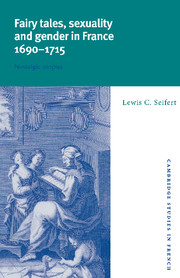Book contents
- Front Matter
- Contents
- Acknowledgments
- Note on translations and quotations
- Introduction
- Part I MARVELOUS STORYTELLING
- Part II MARVELOUS DESIRES
- Chapter 4 Quests for love: visions of sexuality
- Chapter 5 (De)mystifications of masculinity: fictions of transcendence
- Chapter 6 Imagining femininity: binarity and beyond
- Afterword
- Notes
- Selected bibliography
- Index
- Cambridge Studies in French
Chapter 5 - (De)mystifications of masculinity: fictions of transcendence
Published online by Cambridge University Press: 22 September 2009
- Front Matter
- Contents
- Acknowledgments
- Note on translations and quotations
- Introduction
- Part I MARVELOUS STORYTELLING
- Part II MARVELOUS DESIRES
- Chapter 4 Quests for love: visions of sexuality
- Chapter 5 (De)mystifications of masculinity: fictions of transcendence
- Chapter 6 Imagining femininity: binarity and beyond
- Afterword
- Notes
- Selected bibliography
- Index
- Cambridge Studies in French
Summary
Compared to other literary forms, characters in fairy tales occupy a world apart. Perhaps most obvious are the superhuman powers of some and the extraordinary adventures of all characters in this genre. Just as salient as supernatural traits, however, is the predictable, repetitious quality of fairy-tale characterization. In fact, part of what distinguishes fairy tales is that they draw on a set of stock characters – fairies, ogres, tricksters, princes, princesses, and the like – who perform similar (nearly identical) tasks from text to text. So predictable and so repetitious are they that critics have often noted the one-dimensionality of fairy-tale characters. Usually devoid of individuating psychological traits, protagonists and antagonists alike highlight specific narrative and ideological functions. In other words, they are first and foremost incarnations of cultural values. They purvey the norms of the community and reject those of the individual.
Ideologically speaking, the repetition of characters from fairy tale to fairy tale is, in and of itself, highly significant, for it is through repetition that the meanings embodied by characters become self-evident. Susan Stewart has observed that repetition is only truly possible outside of everyday life, and most notably in fiction. “Repetition can only take place in a domain where context is folded into text, where the text can control all variations in context by presenting an illusion of timelessness.” Operating within the controlled time and space of textuality, repetition has a generative power.
- Type
- Chapter
- Information
- Fairy Tales, Sexuality, and Gender in France, 1690–1715Nostalgic Utopias, pp. 138 - 174Publisher: Cambridge University PressPrint publication year: 1996



